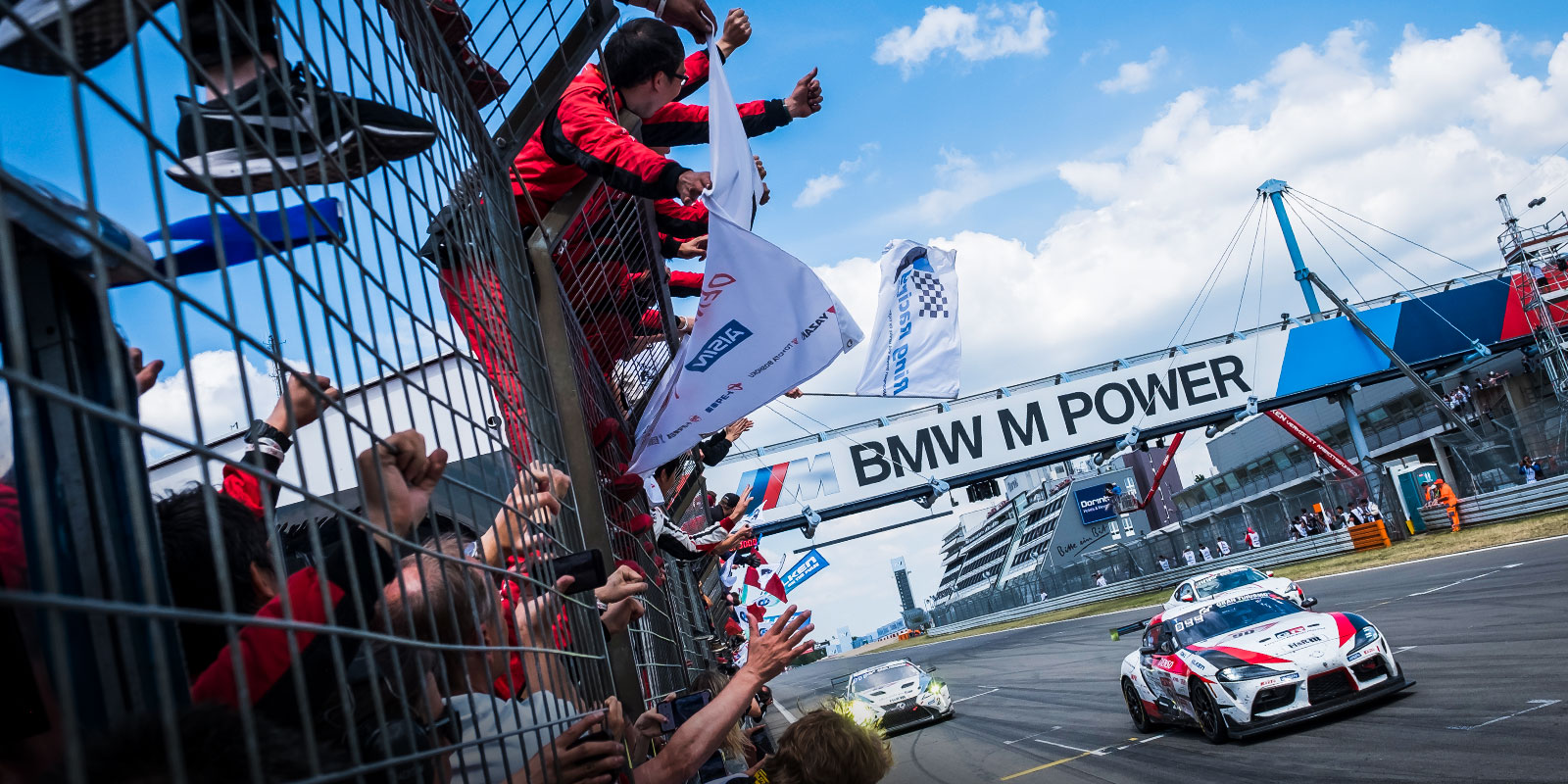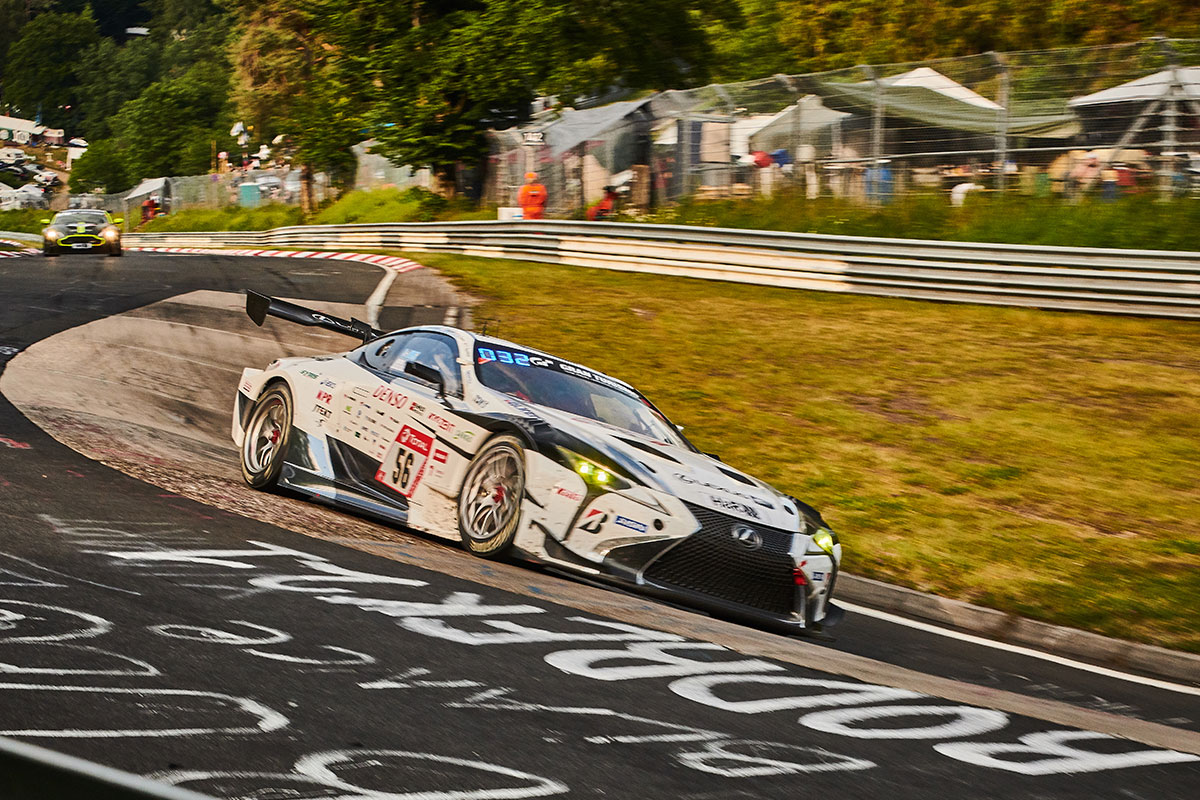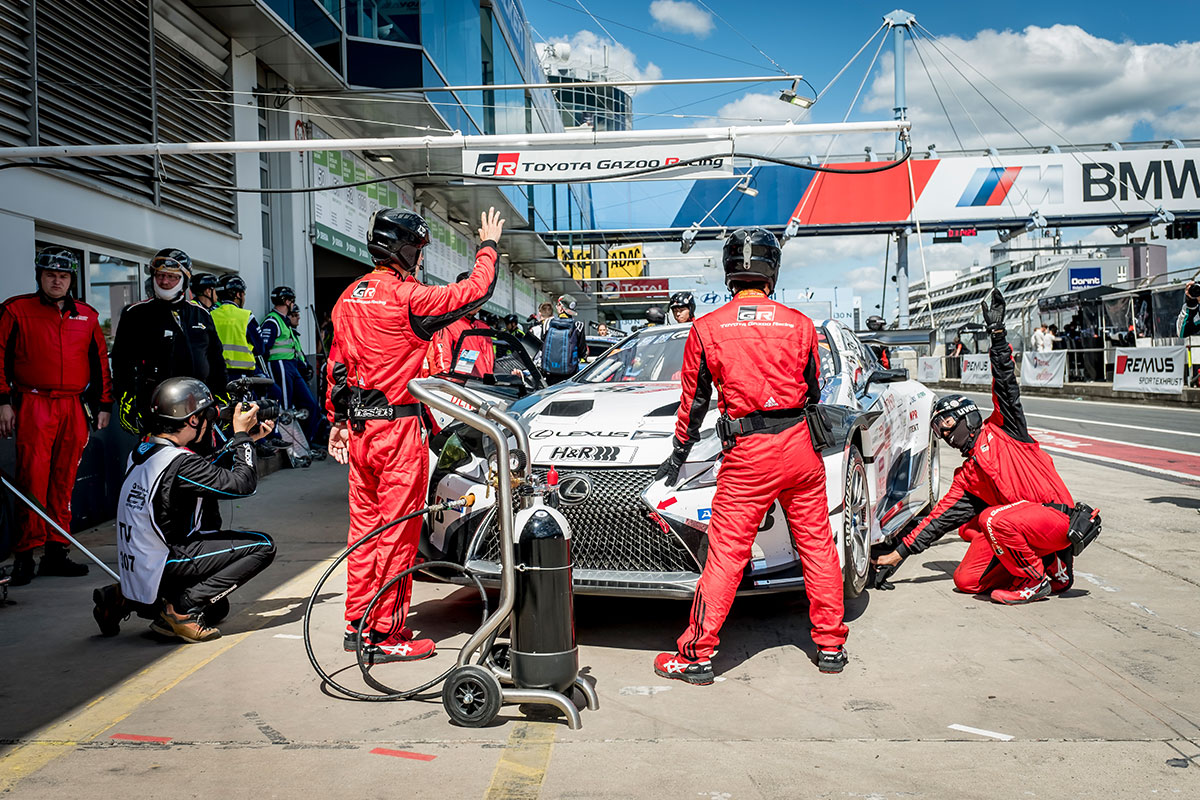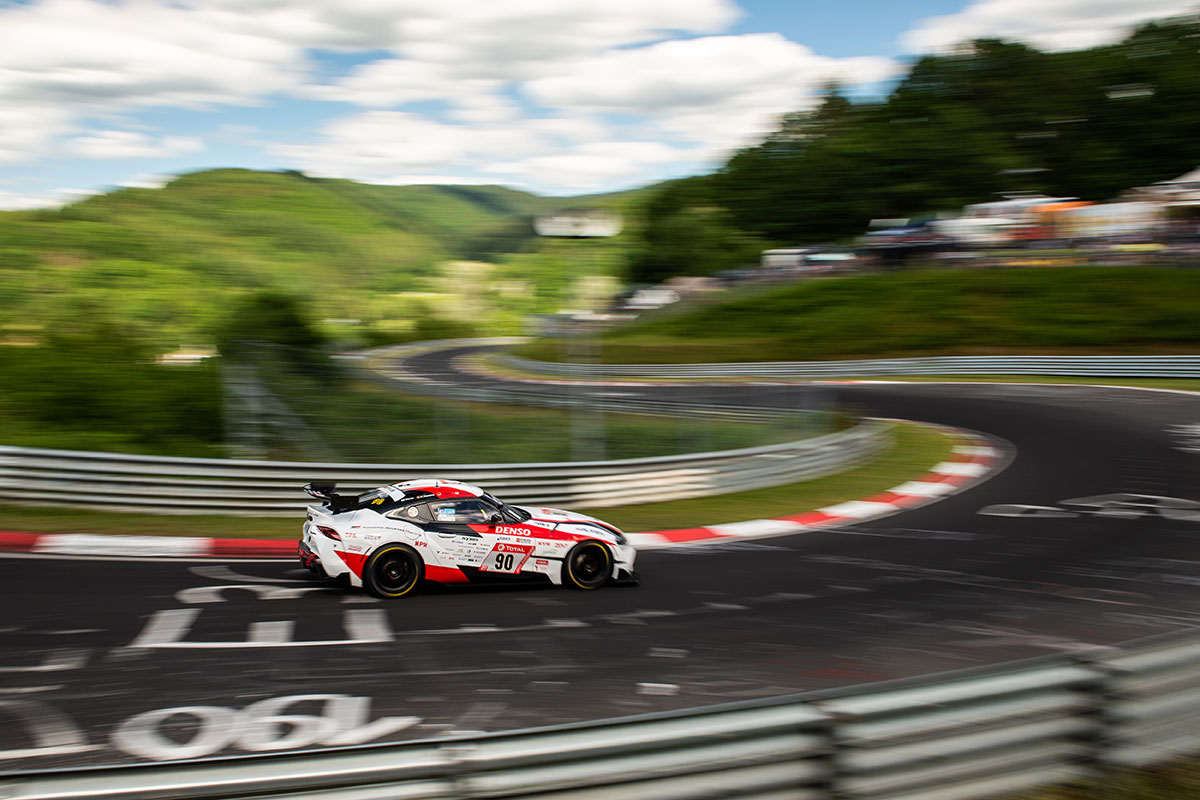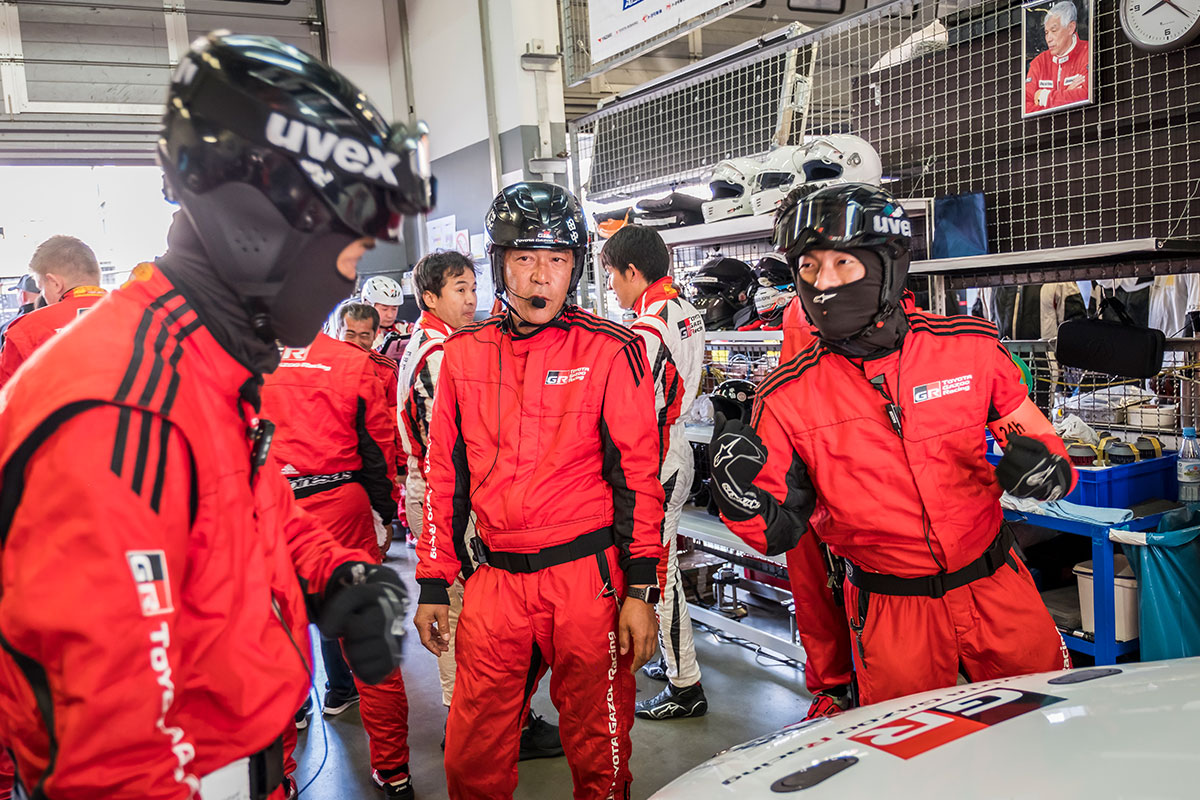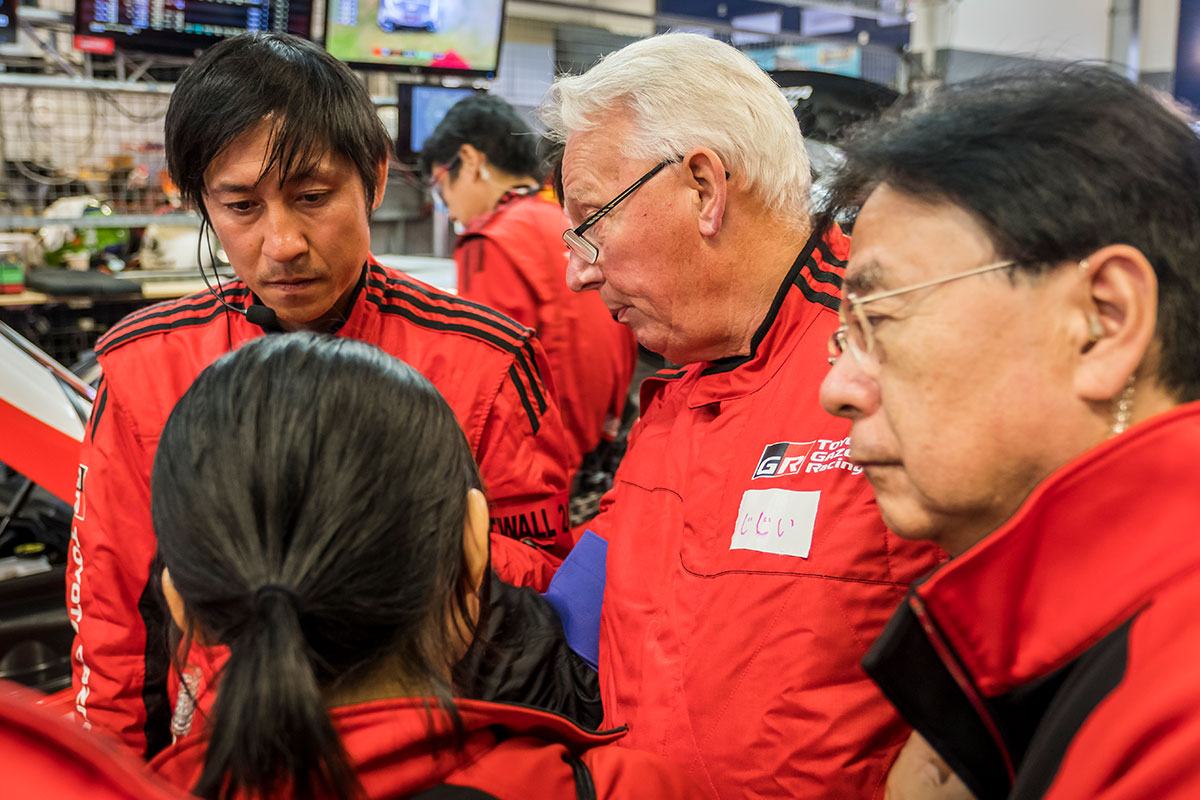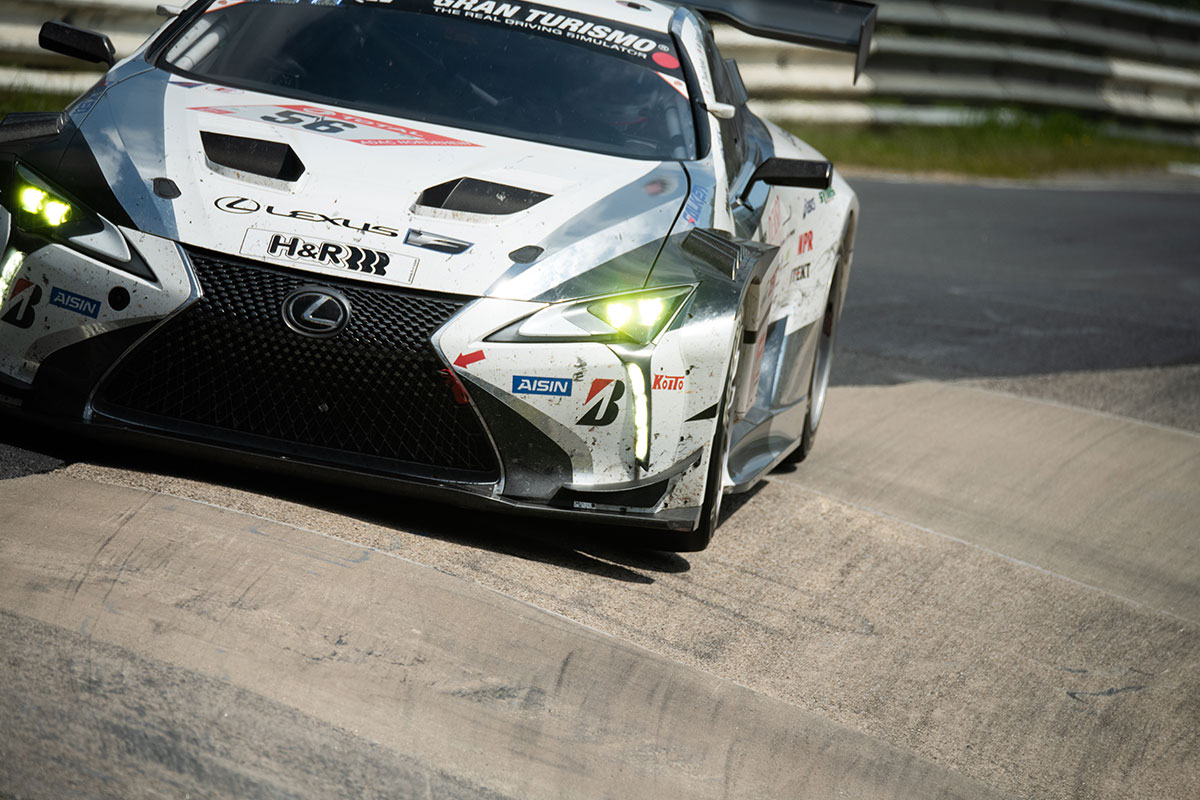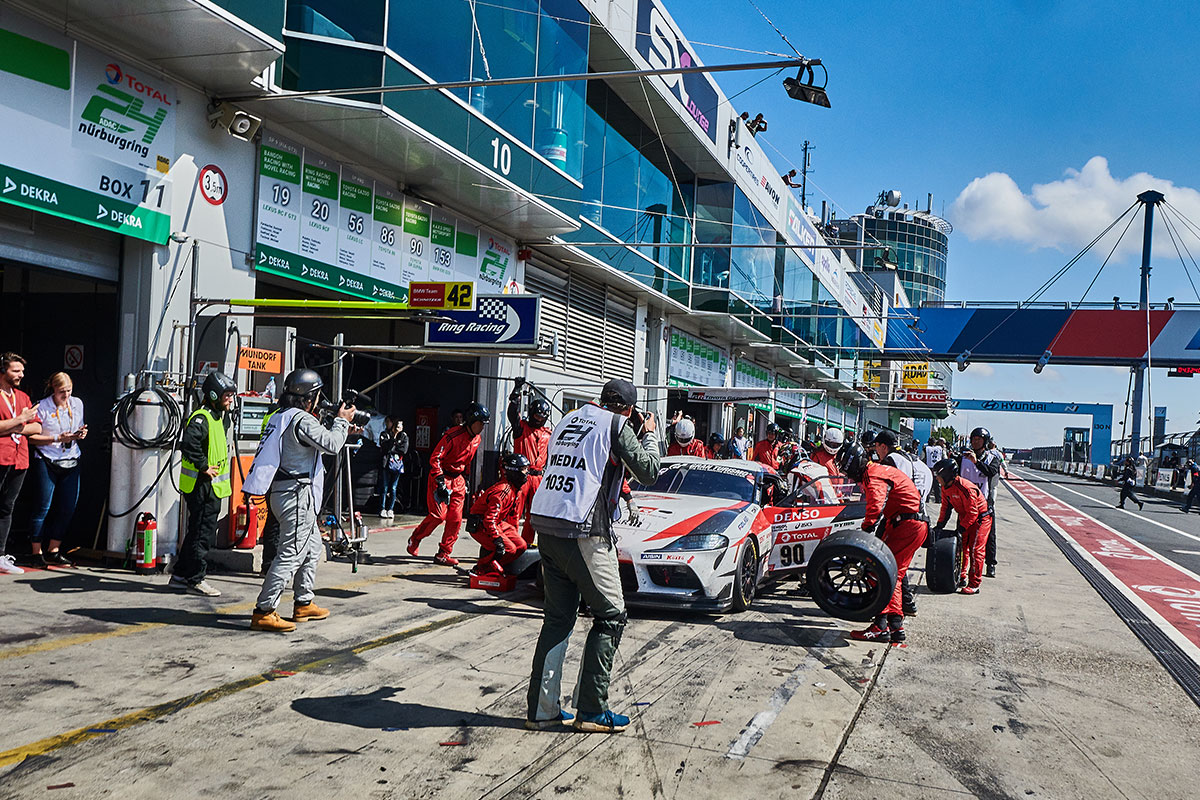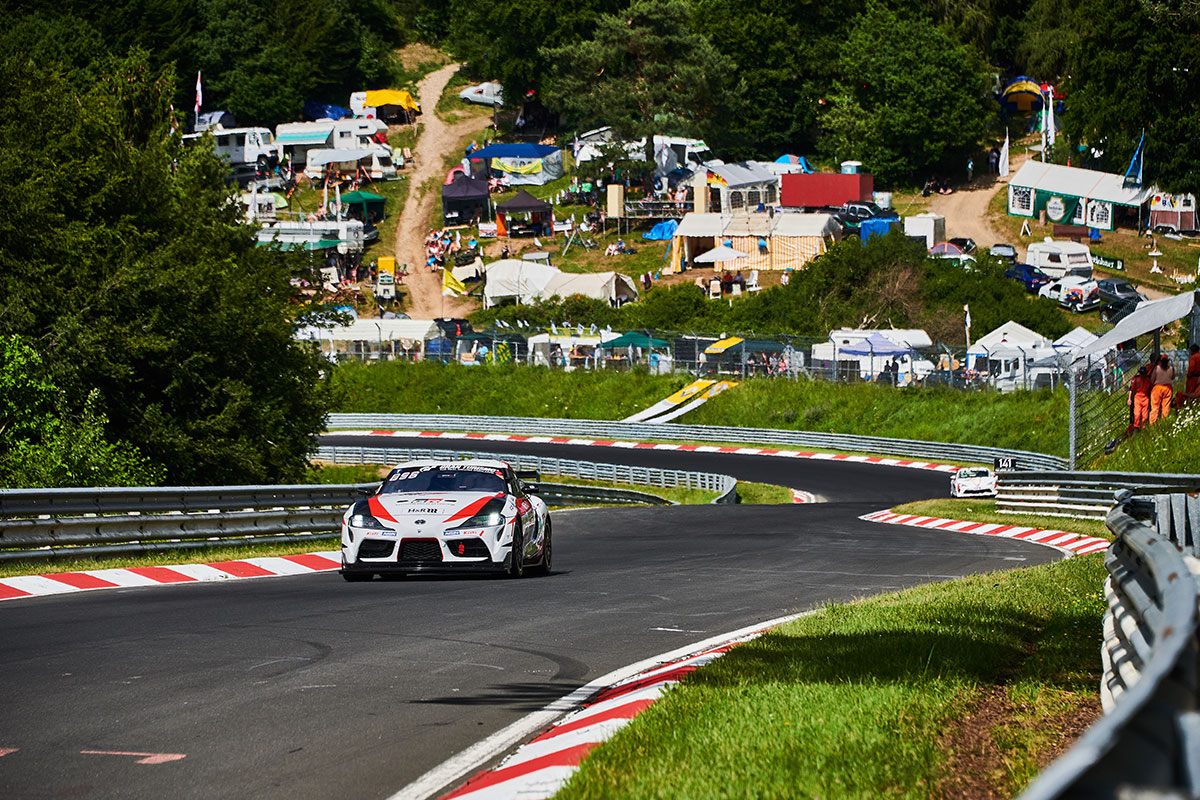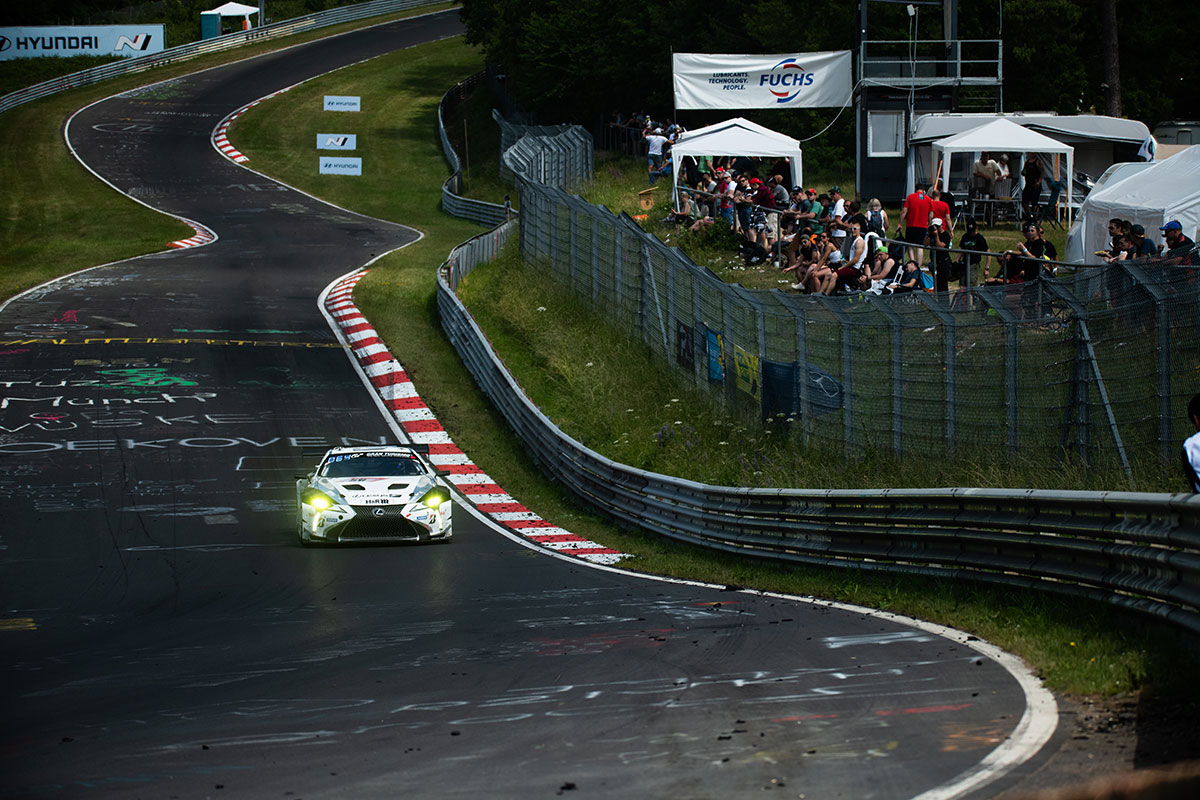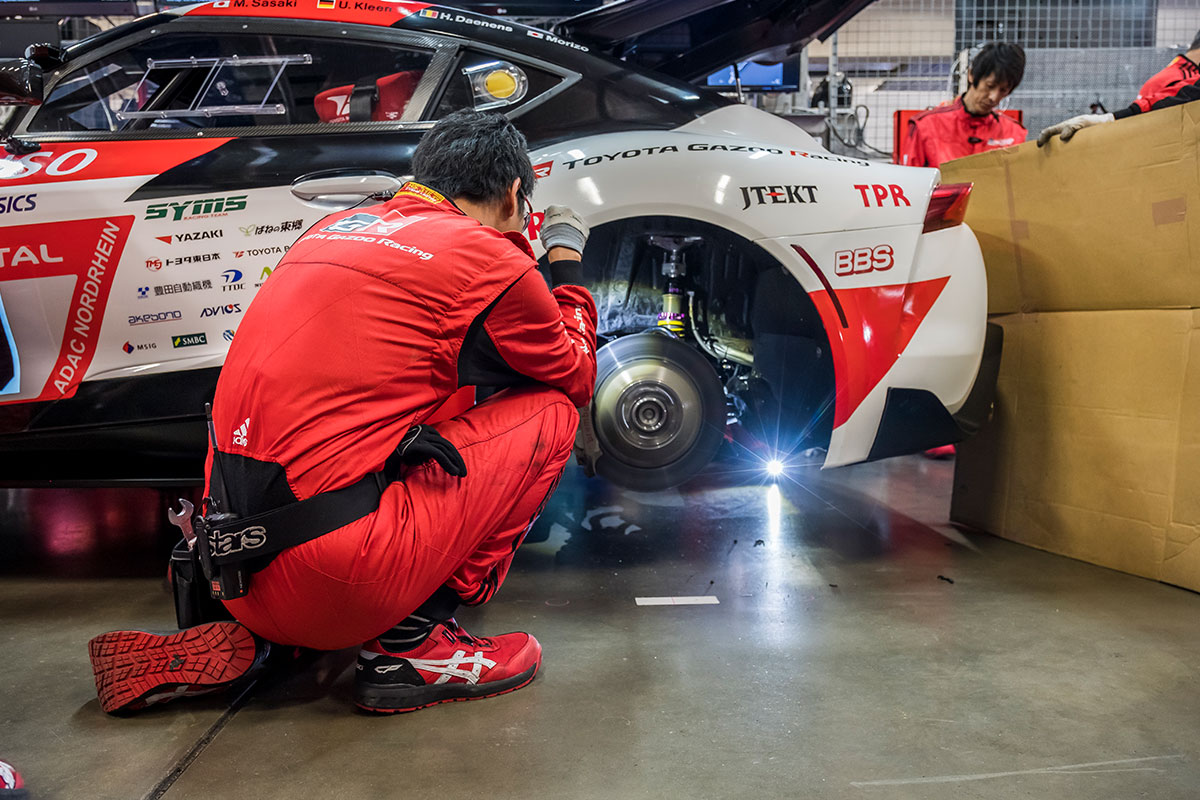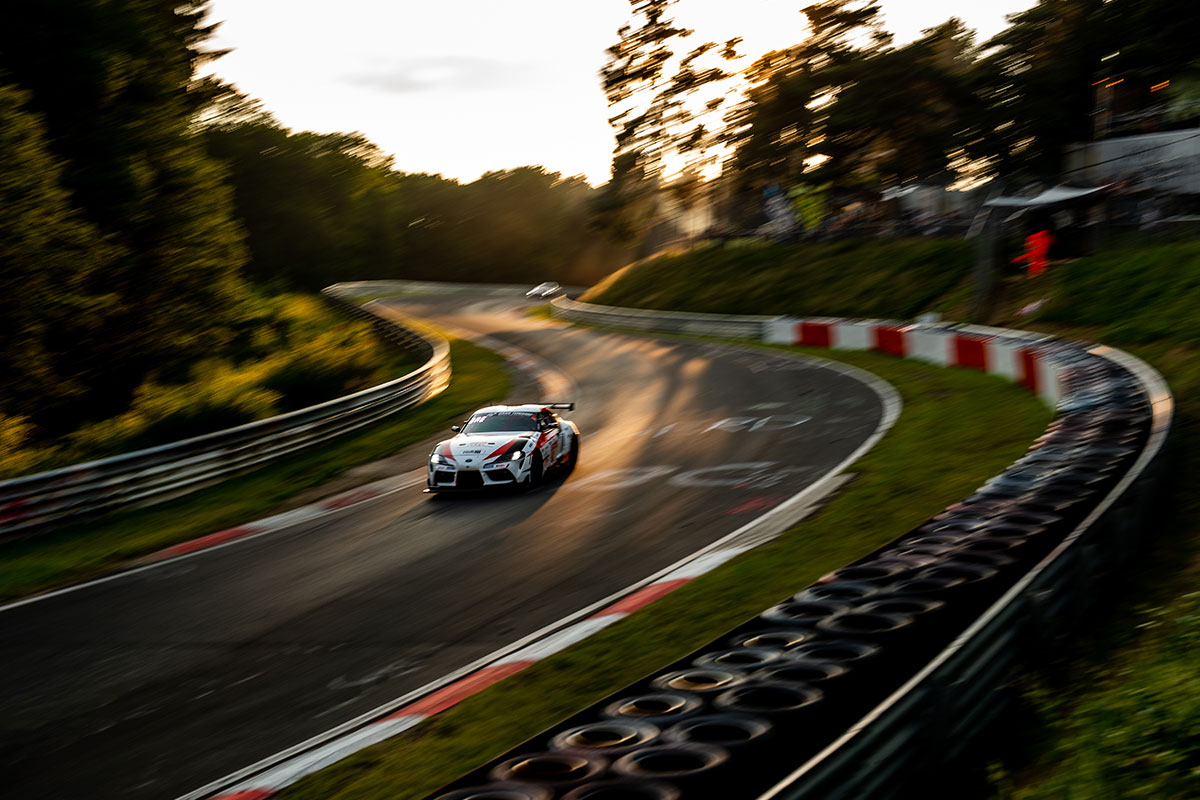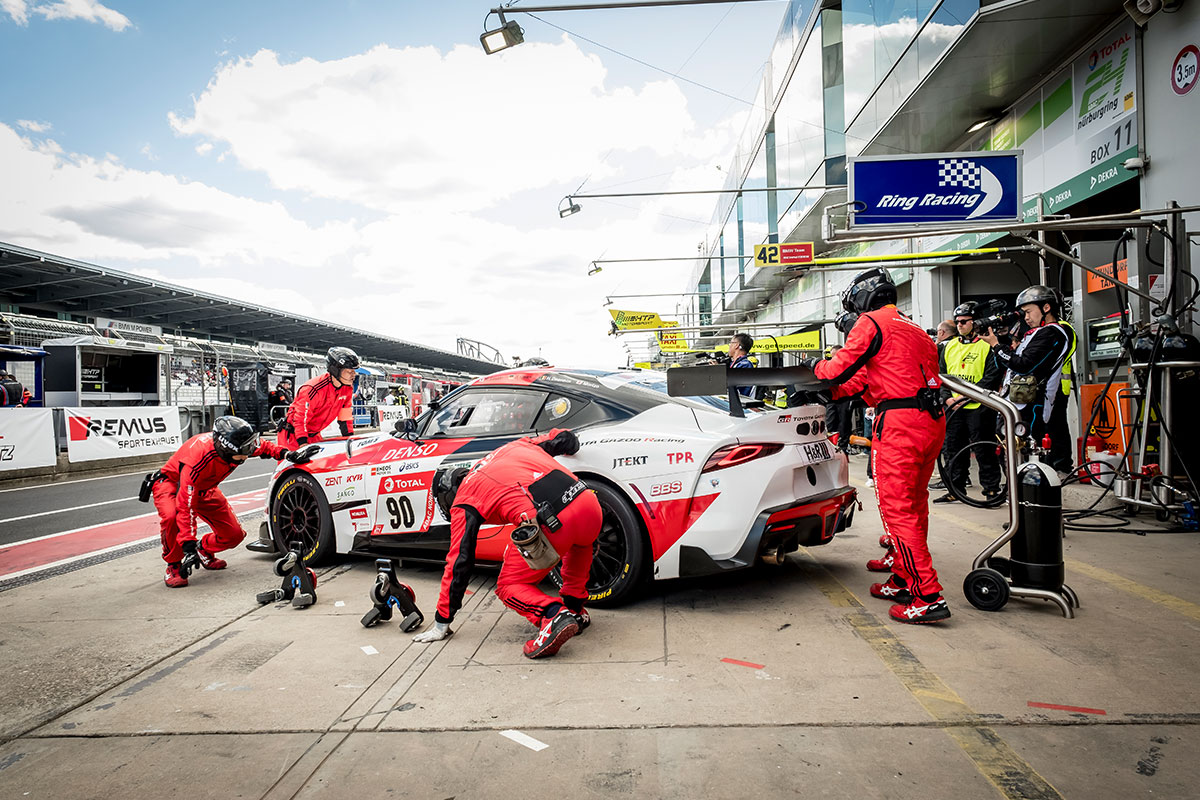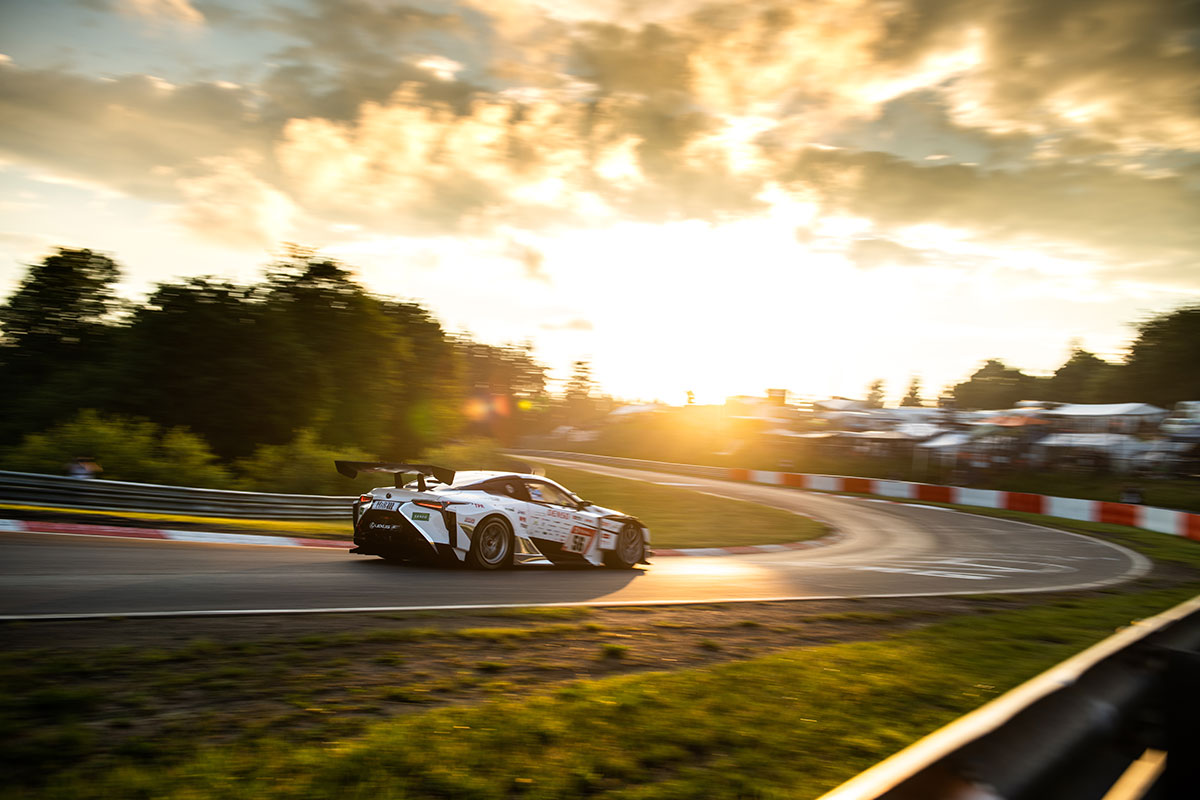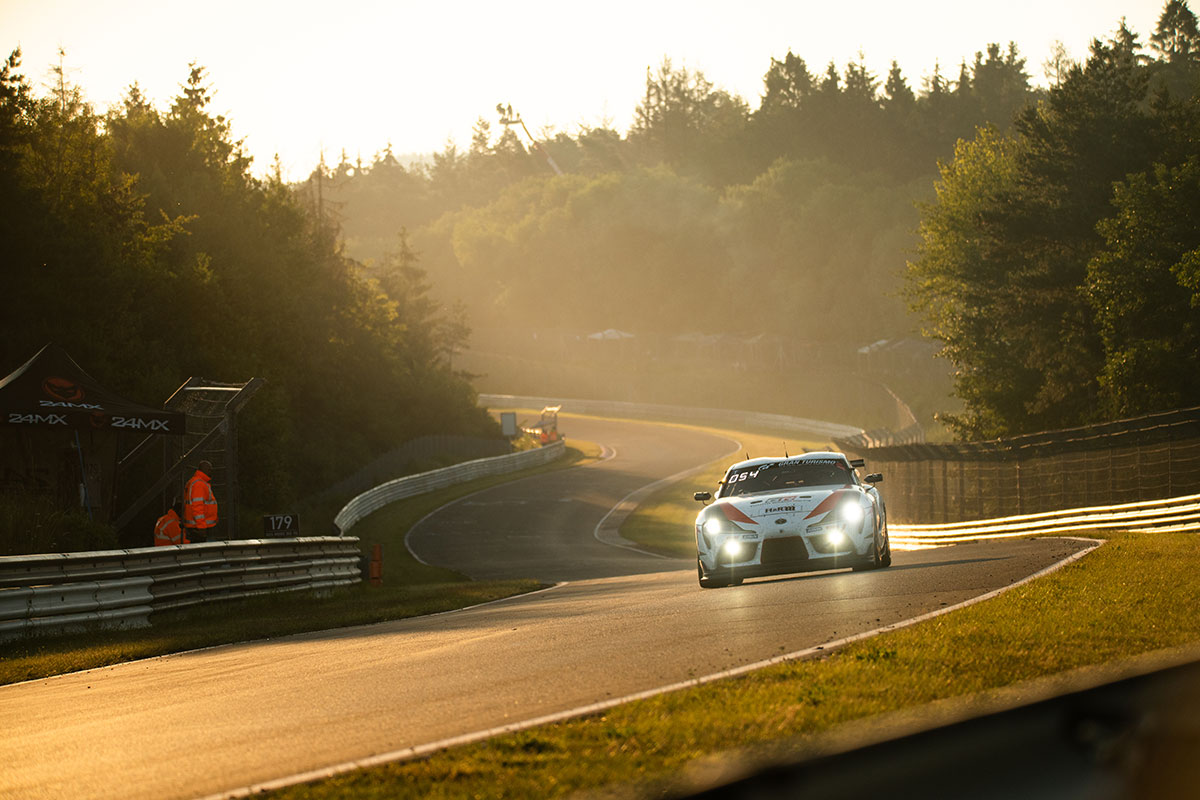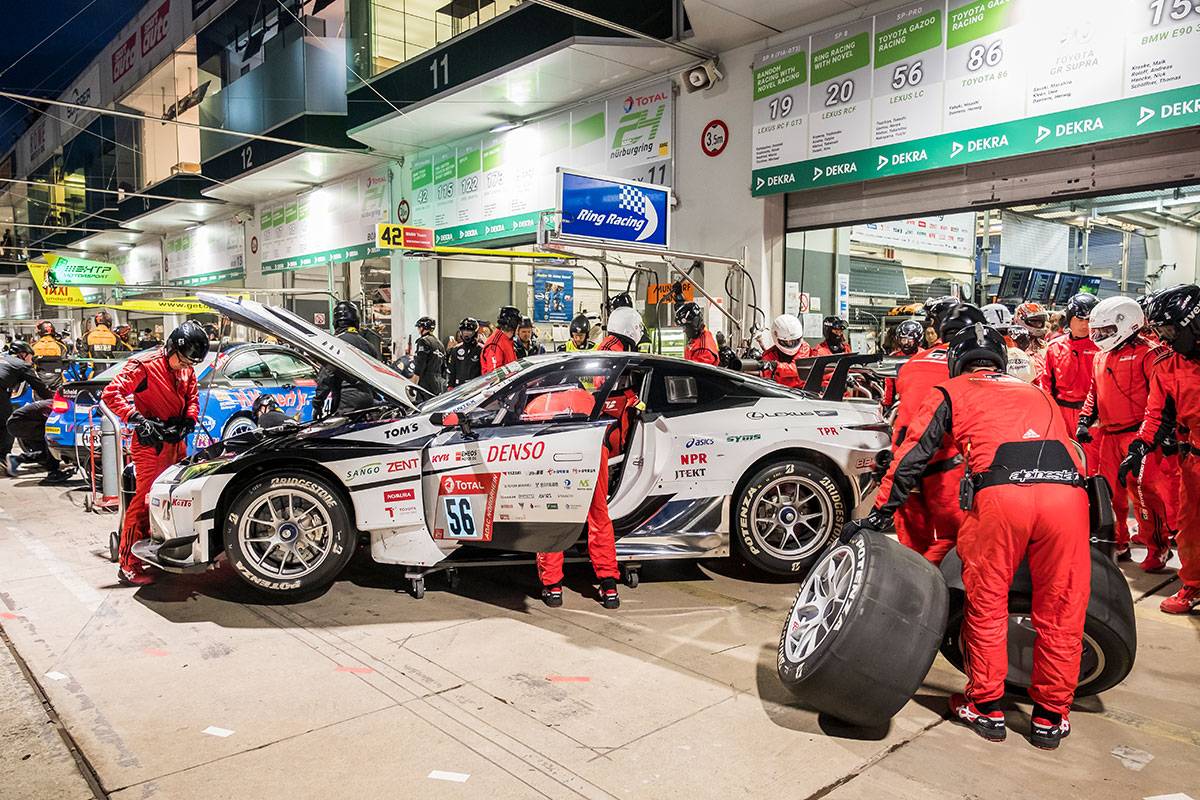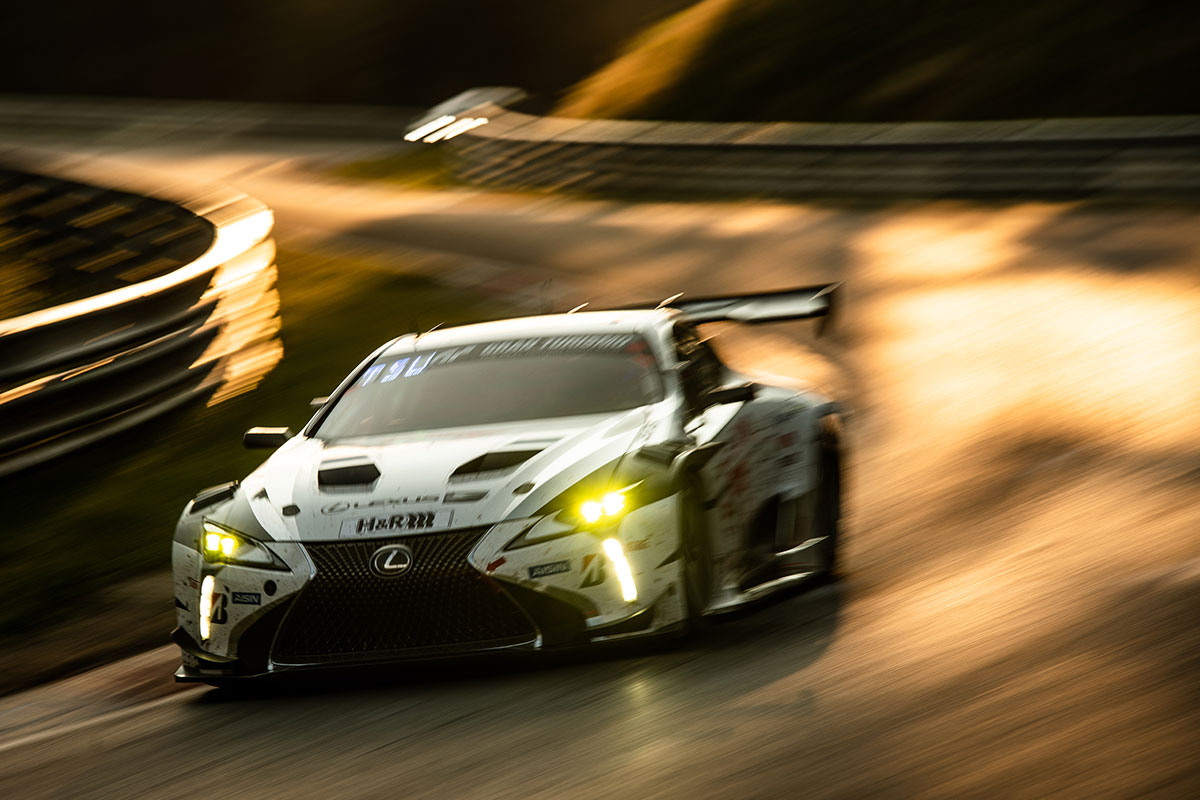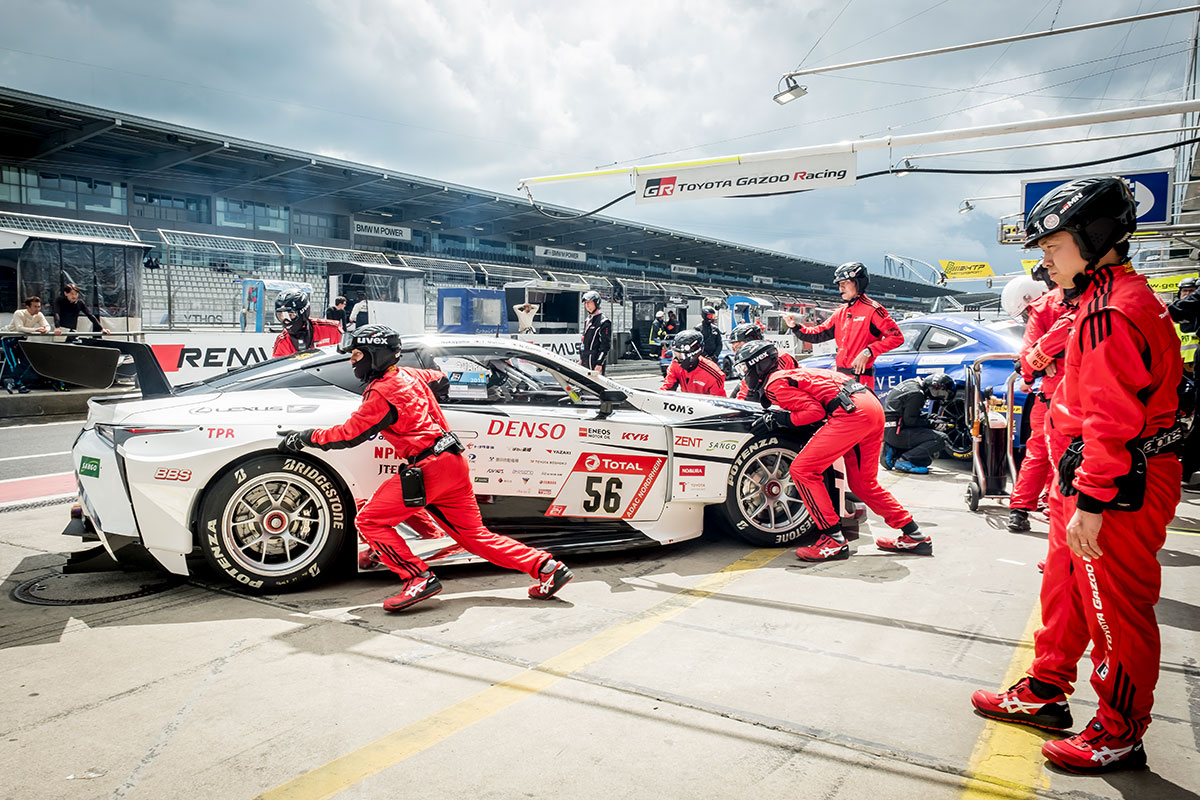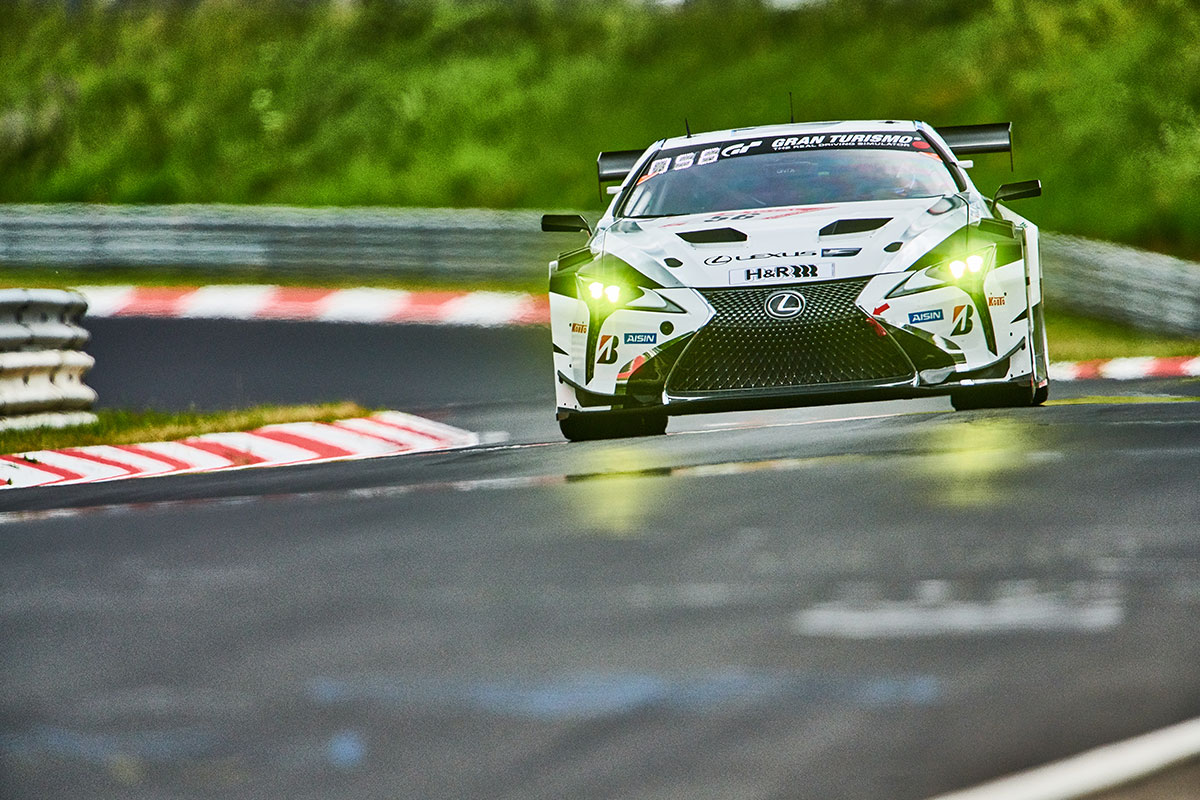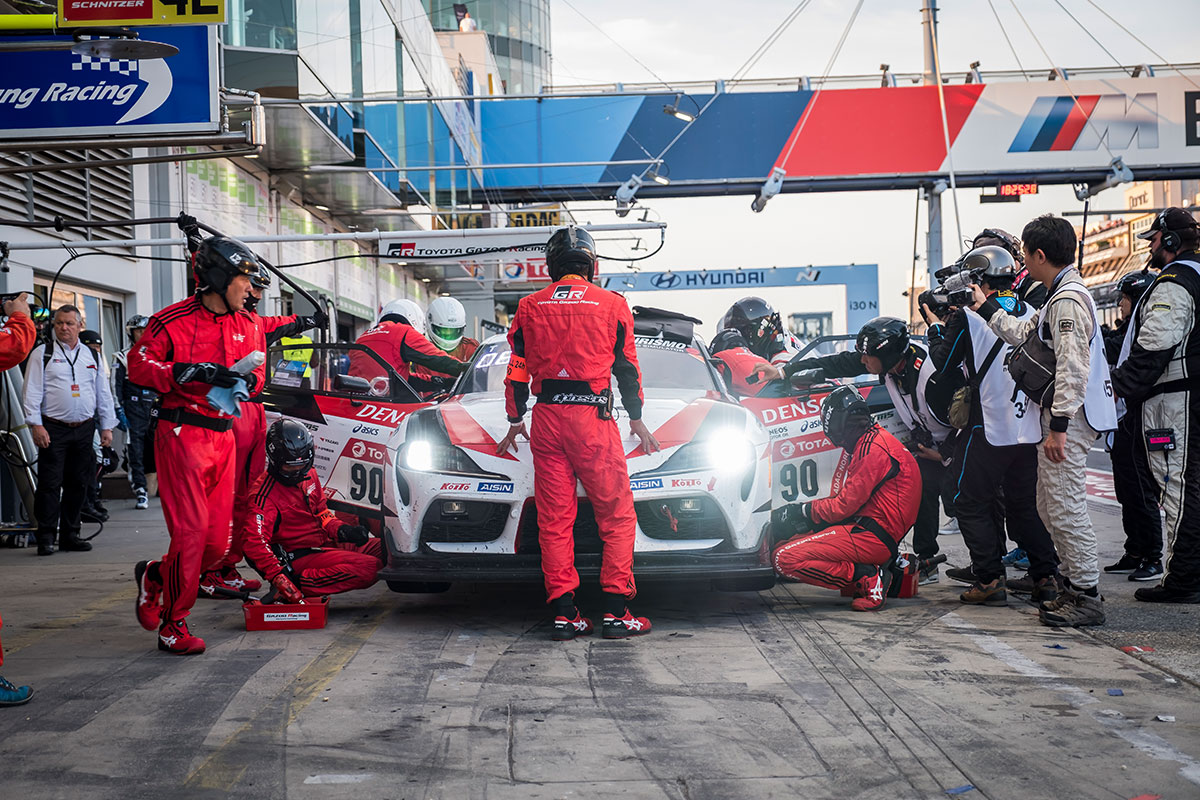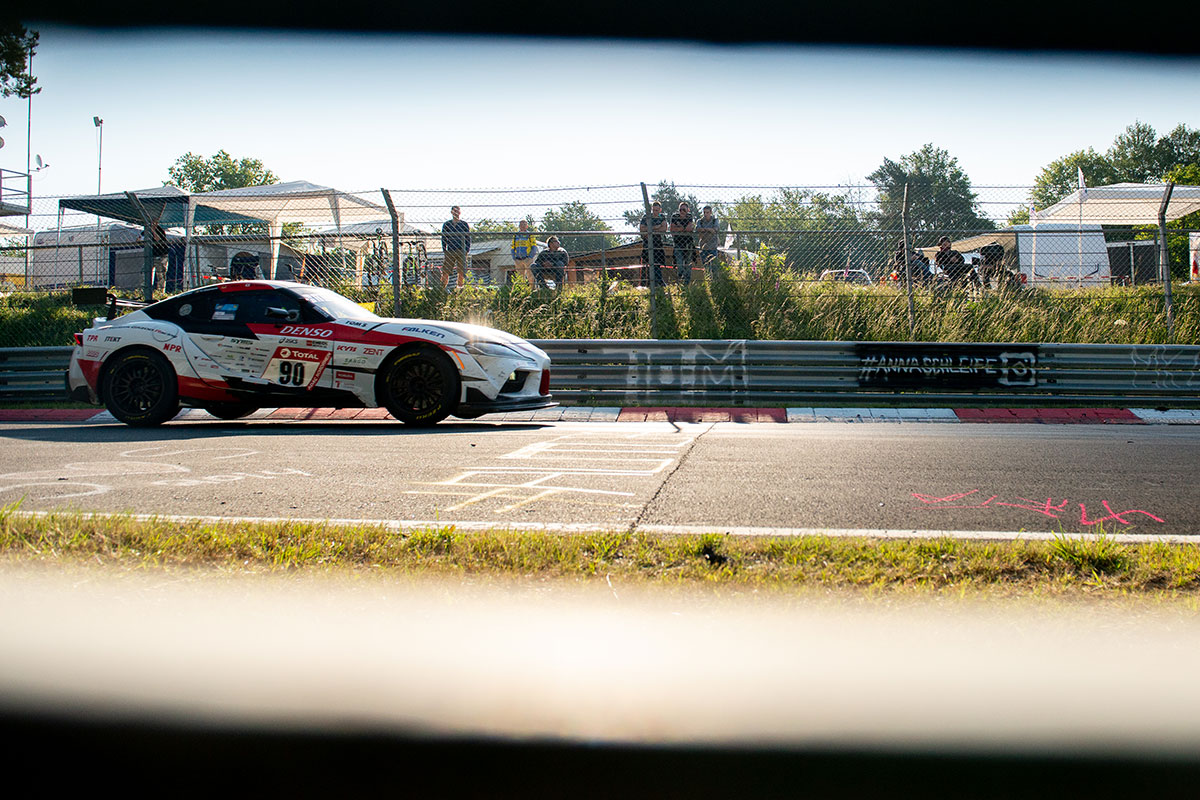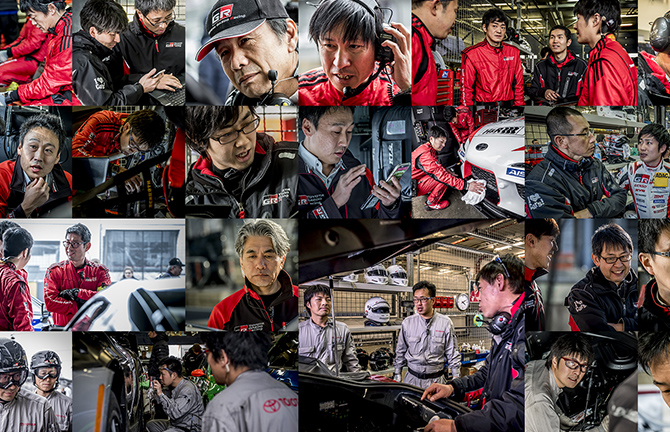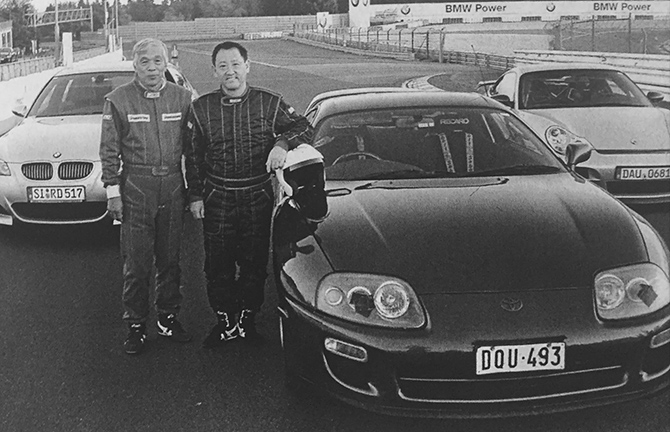Tears of many varieties, and the continuing challenge of making ever-better cars
24 Hours of Nürburgring, 2019: Race Report
The challenge of making ever-better cars has continued without interruption since 2007
GAZOO Racing first competed at the 24 Hours of Nürburgring in 2007. The company has continued its activities without interruption since then, but a variety of changes have taken place in the meantime.
When GAZOO Racing made its debut at the 24 Hours of Nürburgring, it entered the Altezza. Production of this model had been discontinued in 2005, and so the race car had been built using a second-hand car. The team was not permitted to use the Toyota name, and the team was similar in level to a bunch of enthusiasts. Morizo—the race name for Akio Toyoda—established GAZOO Racing with Hiromu Naruse, master test driver for Toyota at that time. Looking back at the team’s first participation, Toyoda recalled:
“In preparation for the 24 Hours of Nürburgring, Toyota carried out its training in a second-hand car, and raced the actual event using a second-hand car as well. However, the other auto manufacturers were competing with new cars that were scheduled for launch in two or three years; Naruse and I said to each other: ‘At Toyota, let us make not only cars that are overtaken by others, but cars that overtake others—and let us one day race in such a car as well!’”
In 2008 and 2009, GAZOO Racing entered the race with an unannounced prototype, the LFA; its intention was to use the Nürburgring to develop the car. In 2010, the company won its first-ever class victory with the car, and acquired a “blue light”—proof of its speed—in 2011. In 2012, GAZOO Racing entered the 86 alongside the LFA. In 2013, in horrendous weather, the company experienced first-hand the strength of its team members; then, in 2014, it secured victory in all three classes it competed in—a first for GAZOO Racing. Since 2015, the team has entered the 24 Hours of Nürburgring under the name TOYOTA GAZOO Racing. In 2018, the LC made its 24 Hours of Nürburgring debut. The Nürburgring has, at times, smiled on the team and, at others, bared its teeth; consistently, though, it has provided a variety of dramas and issues.
Yet one thing has not changed since the team’s debut: it’s reasons for participating in the race. The Nürburgring is widely regarded as the world’s most demanding circuit, and the 24 Hours of Nürburgring held here is the ultimate race. Through its participation, TOYOTA GAZOO Racing seeks to refine its cars, its people, and its teams, and it sees the track as a place where it can develop ever-better cars. If asked whether it aims to win… the response is: “If we can fully resolve the problems we are faced with, then ‘results’ will follow as a matter of course.”
In its 13th year of participating, TOYOTA GAZOO Racing enters two cars: the Lexus LC and the GR Supra
This year marked TOYOTA GAZOO Racing’s 13th year of participation at the 24 Hours of Nürburgring, and it entered two race cars: the Lexus LC advanced development vehicle, which was competing for the second time and was packed with next-generation technologies; and the GR Supra, Toyota’s flagship sports car that has been resurrected after an interval of 17 years. The desires previously outlined by Morizo were actually being realized.
TOYOTA GAZOO Racing commenced its 24 Hours of Nürburgring activities for 2019 on June 19. By the side of a public road not far from the Nürburgring, there is a small park where two cherry trees grow—one Japanese and one German—and, here, all the team members gathered. Behind the cherry trees was the corner where Naruse lost his life in 2010, while taking part in a development test for the LFA. The team members prayed for their safety, and communicated their own goals to Naruse, who played such a key role in enabling TOYOTA GAZOO Racing’s participation at the 24 Hours of Nürburgring.
Qualifying Session One
The team’s actual race participation began on June 20, with free practice and qualifying session one. Toshiyuki Sekiya, chief mechanic of the Lexus LC, said: “We conducted a combined total of 7,000 kilometers of pre-race tests in Japan and at the Nürburgring, and we succeeded in identifying everything that was of concern. We must remember, however, that the Nürburgring has its own god and provides its own enemies.”
In contrast, Hideyuki Tanaka, chief mechanic of the GR Supra, was more apprehensive: “We completed the GR Supra and started running in April. In terms of distance, we haven’t driven it as much as we would like, so it would be misleading to say we have complete confidence. However, we have made improvements to all the problems we have encountered thus far.”
Free practice was held in the afternoon, but part-way through it started raining as if buckets had been overturned in the heavens—the practice session was red flagged; after the session was stopped, however, the weather improved. In this way, the team was subject to the unique climatic unpredictability of the Nürburgring, and neither the Lexus LC nor the GR Supra were able to run as intended.
The first qualifying session started at 20:30 and lasted for three hours. It was a night session that began at sunset. By this time the weather had improved, and the track was beginning to dry; however, with the track still wet in places, the conditions were extremely difficult.
During the 24 Hours of Nürburgring qualifying sessions, it is mandatory for each driver to complete two timed laps in order to drive in the actual race itself. All four of the Lexus LC drivers, and three of the GR Supra drivers—excepting Morizo—cleared the two timed laps requirement. In the Lexus LC, Naoya Gamo set the fastest time of 9 minutes 14.186 seconds—good enough for 54th overall and 1st in the SP-PRO Class—while Masahiro Sasaki set the fastest time in the GR Supra of 9 minutes 38.030 seconds—74th overall, and 6th in the SP8T Class. Morizo, who announced that he would participate as one of the GR Supra race drivers in place of the Advanced Technical Skills Institute’s Hisashi Yabuki, opted not to take part in the session and, instead, familiarized himself with the car by driving the GP course.
Qualifying Session Two
On June 21, the drivers were greeted with dry conditions—a marked turnaround from the day before. Beginning at 14:55, qualifying session two was a shorter affair, lasting just 1 hour 50 minutes. In order to set the best time possible, the timing with which the drivers left the pit lane was crucial. Gamo and Takamitsu Matsui were tasked with taking the wheel of the Lexus LC, with Gamo recording the best time of 8 minutes 34.255 seconds—good enough for 34th overall and 1st in the SP-PRO Class.
Gamo said: “I think I succeeded in putting together all the things I had tried out since VLN1, and drove well. If the course conditions had been better, I would probably have been able to go faster; but I think I was able to show my true pace.”
The GR Supra did not attempt to set a qualifying time in the second session. Morizo alone drove five laps, including the mandatory two timed laps. For this reason, the GR Supra qualified in 99th overall, and 7th in the SP8T Class.
“I have driven a variety of cars at the Nürburgring,” said Morizo, “but the new Supra provides the greatest peace of mind of them all. I was even able to enjoy the final few laps. However, after finishing, I received thorough guidance from Sasaki, who had been watching on-board footage of my driving!”
The race itself took place on June 22. In most years, the team took part in the one-hour warm-up starting at 9:10. This year, however, the Lexus LC and GR Supra did not participate—the team had decided on the setups the previous day, and judged there was no need to run the cars. Instead, the majority of the team members took the opportunity to rest up fully before the start of the 24-hour-long race.
At 11:30, everyone involved in the race was called to the team tent for a pre-race meeting. Akio Toyoda, who was both team representative and driving as Morizo, addressed those present:
“The 24 Hours of Nürburgring is about to start. At the Le Mans World Championships held last week, we entered a works team—Toyota’s goal, as a professional outfit, was to become world champions. Here at the Nürburgring, however, I feel we are less a works team, and more of a Toyota privateer team. This year marks the 13th year of our participation at the race, but I feel that we are returning to the type of team that participated in 2007. Why is Yabuki—who, together with Herwig Daenens, was responsible for perfecting the feel of the Supra—not driving? Why is Morizo driving in his place? In fact, it was Yabuki who approached me, asking: ‘Will you drive the Supra at the 24 Hours of Nürburgring?’ I had thought that my drive in the RC in 2016 was to be my last participation as a driver; however, the resurrection of the Supra, the desire to drive the Supra at the Nürburgring alongside Naruse, and the desire to show myself fighting alongside a team that had been nurtured by Naruse—these were the reasons that made me choose to participate.
“The goal for this year is to drive the cars one lap more, one meter further, one second longer. This is something we cannot do unless the drivers, the mechanics and engineers, the supporters, and the staff and media responsible for broadcasting our race live all pull together. Safety above all else—but beyond that, let us start our engines with a smile on our faces!!”
The Race
The starting drivers were Gamo in the Lexus LC and Morizo in the GR Supra. The 24-hour battle began at 15:30. Both cars got away cleanly, and smoothly started to rack up the laps. Both cars initiated a driver change at almost the same time—Matsui took the wheel of the Lexus LC, while Uwe Kleen took over the GR Supra.
Uwe is the owner of the Ring Racing team, and also has a wealth of experience of driving at the Nürburgring. “Ten years ago,” he recalled, “when I heard that GAZOO Racing was set to take part in the 24 Hours of Nürburgring, I started providing support. Over the years, the team has progressed splendidly. I am extremely grateful I was invited to participate as a member of the team this year. The car was fantastic—extremely easy to drive—and it was an honor to take part alongside so many superstar drivers.”
With Uwe at the wheel, the GR Supra was lapping at around 9 minutes 20 seconds to 30 seconds—surpassing its qualifying time pace—when he reported over the radio: “The AT is shifting up of its own accord.” The problem persisted even after Sasaki took the wheel. The diagnosis of the engineers was that the unexpectedly high temperatures had resulted in high water temperatures, and this was causing the protection circuit to kick in. The issue was resolved with a system reset.
Meanwhile, Yuichi Nakayama had replaced Matsui at the helm of the Lexus LC. Nakayama was competing at the 24 Hours of Nürburgring for the second time, and he was effusive in his praise of the car: “The condition of the car is extremely good. Considering the amount of traffic, our times are also improving. The more you drive the Lexus LC at the Nürburgring, the more you understand the intricacies of the course; and the more you attack with the Lexus LC, the more enjoyment you feel.” However, while decelerating due to a yellow flag, Nakayama’s Lexus LC was hit from behind by a GT3 car. Fortunately, only the diffuser was damaged; since the rest of the car was operating problem-free, the team waited until the next pit stop to repair the car.
The Nürburgring bares its teeth during the night session
When the sun started to set around 22:00, there were a succession of crashes throughout the circuit. However, the TOYOTA GAZOO Racing cars were unaffected, and continued to perform smoothly. At 22:30, six hours after the start of the race, the Lexus LC had risen to 27th overall, with the GR Supra in 73rd overall and second in the SP8T Class. However, the Nürburgring was soon to bare its teeth.
Around 23:00, after it had become fully dark, Matsui reported a problem with the transmission. This was just before a scheduled driver change; the Lexus LC pitted, and the team’s mechanics took a look—they discovered large amounts of oil leaking from the transmission, and Sekiya decided that the transmission needed to be replaced. Replacing the transmission took approximately two hours, and when the Lexus LC returned to the track it had tumbled down the standings to 111th.
At almost exactly the same time as the Lexus LC had pitted, Uwe reported over the radio that he had sustained a minor collision with another car on the GP course, and guided the GR Supra in for an emergency pit stop. There was damage near the right door, and the team set about making temporary repairs. Working quickly, the team was able to minimize any time losses, and the GR Supra soon took to the track again.
Sekiya, chief mechanic for the Lexus LC, said: “The bolt securing the drive shaft and the transmission had come loose, and oil had leaked from the transmission to the drive shaft. We don’t know the cause of the problem, but we have no excuses.”
Thereafter, the two cars continued to operate smoothly, as if nothing had happened.
The finish
It was already daytime when, just after 7:00, Sasaki was replaced at the wheel of the GR Supra by Daenens; the team took this opportunity to replace the car’s brakes. Thanks to the swift and accurate work of its mechanics, the team was able to replace the brakes in the time it took to carry out routine maintenance work such as refueling and replacing the tires. In addition, the routine maintenance work itself was completed more quickly than the time specified—the team’s development was remarkable.
Daenens was one of the evaluation drivers responsible for perfecting the feel of the new Supra, and one of the final pupils to receive instruction directly from Naruse. “When developing the new Supra,” he said, “we inherited its driving feel and character, but we made it more agile. Since the quality of the base production model is extremely high, we were able to significantly increase the car’s potential simply by adding safety equipment, making it lighter, and changing the springs and dampers, tires and wheels, brakes, and aerodynamics. The driving feeling is on the 45-degrees line, so it is extremely easy for anyone to drive.”
At 10:30, Morizo took the wheel of the GR Supra for the third time. He was originally due to take over at 9:00, but there was great significance in this change of schedule. Naruse passed away on June 23—the second day of the race—and he had his accident at 10:30. Morizo joined his hands together before entering the car.
“I was extremely nervous at taking the wheel at the time Naruse died. My head was filled with various thoughts and, to be honest, I was in no real state to drive.” However, Morizo set his fastest time—9 minutes 48 seconds—of this year’s race during this stint. Doubtless, Naruse was seated alongside, guiding him.
With four hours to go until the finish, the Lexus LC once again encountered troubles. Nakayama called in over the radio: “There’s something wrong with the transmission.” He pitted earlier than planned, and the team sought to identify the problem. This time, the cause was determined to be not the transmission itself but the clutch, and so the team worked to drain air from the clutch. It took just 10 minutes from the time the car entered the pits to the time it left; the speed with which the TOYOTA GAZOO Racing team completed its task brought a round of applause from the mechanics of the other teams.
With one hour to go until the finish, Gamo was replaced by Matsui, who was scheduled to complete the Lexus LC’s final stint. He commented: “Sekiya told me over the radio that I could up the pace; I was able to attack and enjoy myself. The Lexus LC is, above all else, fun to drive. This is the aspect of the car that has developed the most, I think. And this is due to the hard work of everyone that has been involved in its development for the past year. I was truly delighted to be assigned the final stint and given the responsibility of taking the car across the finishing line.”
With 30 minutes to go, Uwe was replaced by Morizo at the wheel of the GR Supra. The two TOYOTA GAZOO Racing cars rendezvoused on course and, at 15:30, 24 hours after starting the race, they took the checkered flag together. The GR Supra completed the 24 hours with almost zero issues and finished in 41th position overall and 3rd in the SP8T Class; the LC encountered various problems, but performed strongly afterwards to finish in 54th overall and take victory in the SP-PRO Class.
Tears of many varieties, and the continuing challenge of making ever-better cars
After the conclusion of the race, the entire team gathered for a meeting.
Takeshi Tsuchiya, the lead driver for the Lexus LC, expressed his gratitude: “Thank you—this phrase sums it all up for me. I am a driver who returned after retiring, so I had a strong desire to smooth things over for my successors. I was able to do this because the three young drivers on my team drive well, and because they have matured into reliable drivers. This team is truly the best. It’s unfortunate that this joy has to end with this race.”
For Sasaki—as for the new Supra—this was his first participation at the 24 Hours of Nürburgring. He has now become a fully-fledged member of the GR family: “After being invited to take part, I felt the pressure of racing the new Supra. However, I believe I have done everything I was able to do. Since VLN1, I have received the support of the team and staff; the fact that we were able to complete the entire 24 hours without making any mistakes is down to everyone’s help. As a bonus, we also managed to finish third in our class. I am extremely happy.”
Tanaka, chief mechanic of the GR Supra, commented with tears in his eyes: “Until this race, the GR Supra had only raced four hours in a row. However, we were able to complete the 24 hours with almost zero issues. There was a great deal of responsibility, but we managed to finish this race through the teamwork of the drivers, the assistance of our supporters, and through the hard work of our mechanics.”
Sekiya also had tears in his eyes, but they were of a more regretful variety: “We started this year’s 24 Hours of Nürburgring with the goal of avenging last year’s disappointments, but we failed once again. Although the car was defeated, the team members themselves performed admirably during the race itself—that, at least, was a victory for us…”
Morizo was the last to speak.
“To begin with, let me say thank you to everyone involved.
“Today is the anniversary of Naruse’s death. Originally, my third stint was supposed to start at 9:00; however, this was changed to 10:30—the significance being that this was the time at which Naruse had his accident and passed away. Gripping the steering wheel at the time Naruse died… I was extremely nervous. During this third stint, my head was filled with various thoughts—“the return of the Supra,” and “our 13th participation at the 24 Hours of Nürburgring”—and, to be honest, I was in no real state to drive.
“When Naruse passed away, at his funeral I said—‘Only those people who want to take part should take part—these are the people I want with me’—and this was how the GR activities began. Now, the GR project has the support of so many people, and is at the very center of our efforts to make ever-better cars, and to improve our human resources. Truly, I want to thank everyone who has supported these efforts so far.
“When it comes to speaking about Naruse, I can’t hold back my tears. The reason is disappointment. Thirteen years ago, we were not even able to use the Toyota name; our team comprised basically two people—Naruse and myself—and we participated in the 24 Hours of Nürburgring with a homegrown team that had fewer members than most privateer teams.
“Back then, I was overcome by various disappointments—the disappointment of not receiving any support; the disappointment of not being taken seriously, no matter what we did; the disappointment of being belittled, no matter what we did; and the disappointment of having to run a Supra model that was no longer in production. I was appointed president on June 23, 2009, and ever since Naruse passed away, exactly one year later on June 23, 2010, all these disappointments have remained with me continually. These disappointments are the reason that all I do is repeat the mantra: ‘let us make ever-better cars.’
“There are people who cried tears of disappointment today as well. I believe that this disappointment will make them stronger, help them make good friends, and encourage them to create ever-better cars.
“In addition, at this year’s 24 Hours of Nürburgring, I drove four stints—including the start and the finish. If it had been any other day, I would have said to Yabuki: ‘Yabuki, you drive.’ However, due to the three key elements of June 23, the Supra, and the Nürburgring, I felt as if Naruse had said to me: ‘No, you should drive. We can drive together!’
“As a driver, no doubt I proved a hindrance to my teammates. However, the other three professional drivers covered for me exceptionally well. Thank you!”
This year’s 24 Hours of Nürburgring gave rise to a wide range of emotions. However, what has remained unchanged is the fact that this race is not the goal—rather, it is the starting point for making ever-better cars. The team will doubtless demonstrate how much it has grown at next year’s 24 Hours of Nürburgring.
*Ranking as of July 8th
